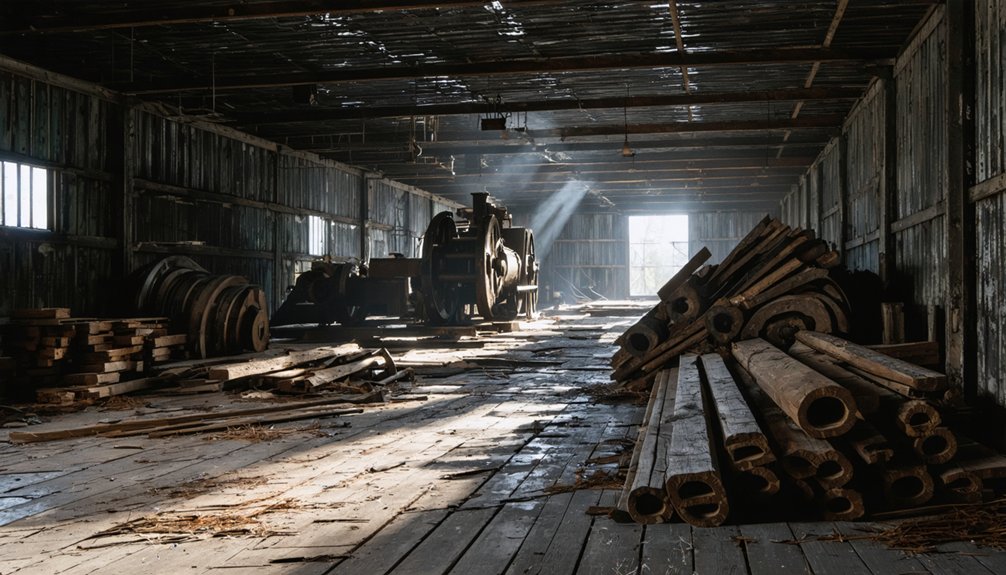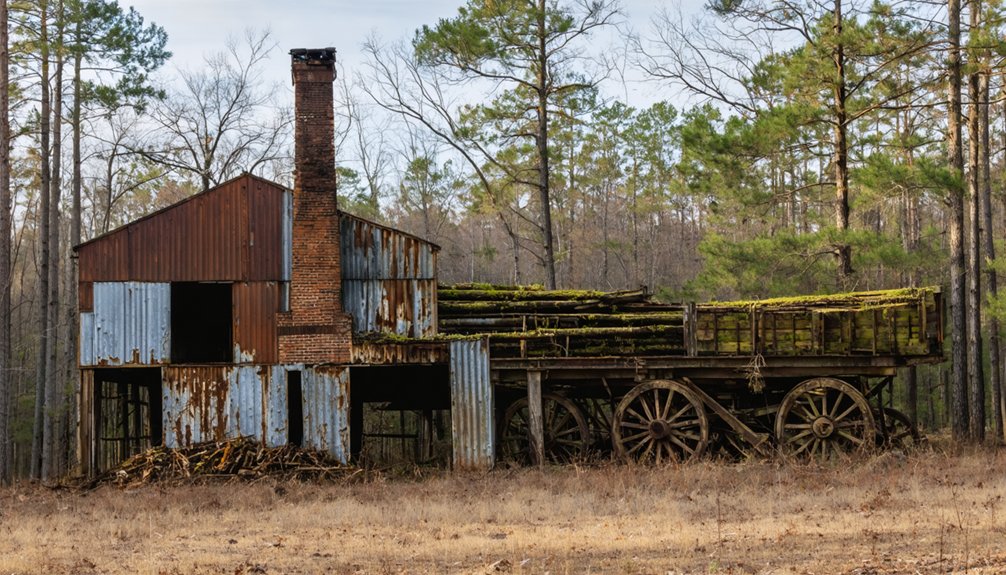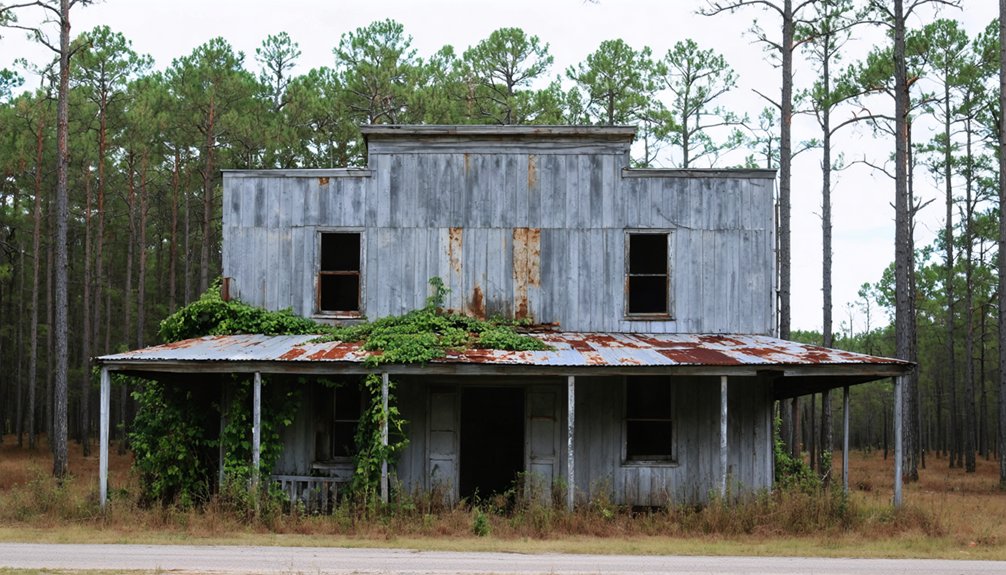You’ll find Lemonville’s fascinating story in southeast Texas, where it emerged in 1901 alongside the Kansas City Southern Railroad. The Lemon Lumber Company’s sawmill transformed this raw forestland into a thriving community of 600 residents, with R.M. Williamson’s commissary and a busy post office serving as social hubs. Though the town declined by 1928 due to timber depletion, traces of this once-bustling lumber community still whisper tales of its golden era in Texas history.
Key Takeaways
- Lemonville was a prosperous lumber company town established in 1901 near Kansas City Southern Railroad, reaching 600 residents at its peak.
- The town thrived around Lemon Lumber Company mill, which produced up to 125,000 board feet daily under Alexander Gilmer’s ownership.
- Residents relied on R.M. Williamson’s commissary and the post office for daily needs in this close-knit community.
- Unsustainable logging practices and timber depletion led to the town’s decline, with the post office closing in 1928.
- Today, only scattered remnants of the former lumber town remain, with nature reclaiming the area.
The Birth of a Lumber Town
While many Texas towns emerged organically around crossroads or waterways, Lemonville’s birth in 1901 was deliberately orchestrated around the lumber industry.
William Manuel strategically filed the town plat near the Kansas City Southern Railroad tracks in northern Orange County, recognizing the crucial importance of rail transport for lumber shipment.
You’ll find that Lemonville quickly transformed from raw land into a bustling community centered around the Lemon Lumber Company mill.
With an initial capacity of 30,000 board feet daily, the mill drew workers and their families, growing to 300 residents by 1902.
The establishment of a post office under Cornelius P. Ryan and the company’s strategic purchase of town lots created a true company town, where your success was tied directly to the mill’s prosperity.
Alexander Gilmer’s nearby Laurel lumber mill became a significant contributor to the area’s booming timber industry.
Due to the multiple locations named Lemonville, historical records required careful place name disambiguation to distinguish this Texas ghost town from other similarly named places.
Life in Early Lemonville
If you’d lived in early Lemonville, you’d have found most of your daily needs met at R.M. Williamson’s commissary, which served as the community’s central shopping hub.
Your daily schedule would’ve revolved around the lumber mill’s operating hours, with the rhythmic sounds of circular saws and planing equipment marking the passing time. The mill’s impressive output of 100,000 feet daily kept the town’s economy humming by 1905.
The Texarkana and Fort Smith Railway had brought new life to the area when development first began in 1898.
You’d have relied on Postmaster Cornelius P. Ryan‘s office as your crucial link to the outside world, handling both personal correspondence and business communications for the town’s 300 residents.
Community Services and Shopping
Since its establishment in 1901, Lemonville’s community services centered around the town’s post office and Williamson’s commissary, which served as essential hubs for the roughly 300 residents.
You’d find postal services managed by a succession of postmasters, including Cornelius P. Ryan, C. B. Payne, and R. M. Williamson, handling your mail and connecting you to the outside world via the Kansas City Southern Railroad.
At Williamson’s commissary, you’d get your basic necessities and provisions, primarily serving mill workers and their families. The local church services played a vital role in bringing the community together each week.
While shopping options were limited to essentials, the railroad’s proximity guaranteed steady supplies.
However, as the lumber industry declined in the late 1920s, you’d witness the retail decline firsthand – the post office closed in 1928, and the commissary’s operations dwindled, marking the end of Lemonville’s vibrant community services.
Daily Mill Worker Routines
Life at Lemonville’s sawmill demanded grueling dedication from its workers, who endured 10 to 12-hour shifts six days a week.
You’d start your day at sunrise, walking from your company-provided cabin to operate heavy machinery, sort lumber, and maintain equipment. Worker schedules revolved entirely around the mill’s production demands, with brief breaks for meals at the communal mess hall.
The harsh labor conditions meant you’d spend your days:
- Operating large circular saws and planers while constantly clearing sawdust and debris
- Loading and unloading timber from railroad cars and horse-drawn wagons
- Performing essential maintenance like sharpening saw blades between shifts
After your exhausting shift, you’d return home to rest in basic housing near the mill, with limited time for social activities at the commissary or local church before starting another demanding day.
Alexander Gilmer’s Golden Era
When Alexander Gilmer acquired the Lemon Lumber Company in 1904, you’d witness the town’s swift transformation as he tripled the mill’s production to 100,000 feet per day by introducing band saws and gang saws.
Under Gilmer’s innovative leadership from 1904-1906, Lemonville experienced unprecedented growth with a bustling population of 600 residents and extensive lumber exports to European markets. His company owned vast timberland holdings of 50,000 acres to sustain the mill’s operations. Despite his success, Gilmer had to rebuild after multiple sawmill fires threatened his operations in Orange.
You’d find his business acumen reflected in the mill’s modernization efforts, which included providing workers with health insurance, housing, and amenities that helped establish Lemonville as a thriving lumber community during its golden years.
Mill Expansion Under Gilmer
After acquiring the Lemon Lumber Company in 1904, Alexander Gilmer transformed the modest Lemonville mill into a powerhouse of lumber production through aggressive modernization and expansion.
His mill modernization efforts tripled daily capacity from 30,000 to 100,000 board feet, creating a substantial economic impact on the region. You’ll find that Gilmer’s $100,000 investment in cutting-edge technology, including double-cutting band saws and gang saws, revolutionized local lumber production.
- Installation of a Cincinnati sawmill boosted daily cutting capacity by 15,000 feet, though initial mechanical adjustments were needed.
- Strategic location near Kansas City Southern Railroad enabled efficient timber transport and profitable export operations.
- Production scaling attracted 600 residents to Lemonville, establishing a thriving community centered around lumber operations.
Economic Boom Years 1904-1906
Under Alexander Gilmer’s visionary leadership, Lemonville experienced unprecedented economic growth from 1904 to 1906, as daily lumber production soared from 30,000 to 100,000 board feet.
You’d have witnessed the town’s population surge to 600 residents as workers flocked to the bustling sawmill operations, which now included advanced band and gang saws.
The town’s prosperity reflected in its modern amenities – you’d have found electricity, running water, and worker housing throughout the community.
While timber sustainability wasn’t a primary concern, Gilmer’s progressive approach included health insurance for mill workers.
Despite his declining health in 1905, the operation expanded to include European exports and leveraged its strategic position along the Kansas City Southern Railroad.
This economic boom established Lemonville as a significant lumber producer, though rapid timber depletion would eventually challenge its longevity.
Innovative Lumber Production Methods
Throughout Alexander Gilmer’s golden era, Lemonville’s sawmills revolutionized lumber production through cutting-edge technology and innovative milling practices.
You’d find the mills equipped with high-speed band saws that brought unprecedented lumber efficiency, producing up to 100,000 board feet daily. The integration of steam-powered carriages and specialized equipment like clippers, edgers, and trimmers transformed raw timber into refined products with minimal waste.
- Advanced saw technology included shifting from circular to band saws, maximizing precision cutting and reducing material loss
- Steam-powered operations streamlined log transport within mills while supporting specialized finishing equipment
- Strategic fire recovery led to mill reconstruction with improved designs and more resilient components
When you consider Gilmer’s systematic approach to timber management and technological upgrades, you’ll understand how Lemonville became a powerhouse in Southeast Texas’ lumber industry.
Daily Operations at the Sawmill

While the Lemonville sawmill started with a daily capacity of 60,000 board feet in 1905, technological upgrades soon pushed production to 100,000 board feet per day.
Under the ownership of Alexander Gilmer, the facility expanded to reach 125,000 feet daily.
You’d find workers operating in 10-hour shifts, utilizing a combination of band saws and gang saws to maximize sawmill efficiency.
The daily workflow involved specialized crews – from fellers working in nearby pine forests to water men managing log transportation.
Skilled crews worked in harmony at the sawmill, with teams dividing tasks from forest cutting to waterway transport operations.
Labor productivity depended on coordinated efforts between those hauling timber by water routes and tram railroads, and the mill workers processing logs through double circular saws.
Supervisors oversaw critical tasks like equipment maintenance and safety protocols while managing the continuous flow of lumber processing, from initial cutting to sorting and shipping for both domestic and European markets.
The operation continued until local timber became depleted, forcing many sawmills to consolidate or shut down entirely.
Community Growth and Development
The founding of Lemonville in 1901 marked the beginning of rapid community expansion, fueled by the booming lumber industry and strategic placement along the Texarkana and Fort Smith Railway.
You’ll find that community dynamics were shaped by labor migration as workers and their families flocked to the area, drawn by abundant mill jobs. Within just one year, the population surged to 300 residents, most of whom worked at the sawmills. Like many Texas towns facing economic changes, Lemonville’s prosperity depended heavily on industry stability.
- The establishment of a post office in 1902 created an essential communication hub for residents and businesses.
- Strong social bonds formed among mill workers and their families, creating a tight-knit community.
- The town’s development centered around the lumber industry, with Alexander Gilmer’s investment driving infrastructure growth.
The Decline of the Timber Industry

Despite Texas reaching its pinnacle as America’s third-largest lumber producer in 1907 with over 2 billion board feet, you’ll find that Lemonville’s fate mirrored the industry’s devastating decline.
The aggressive “cut-out-and-get-out” practices left vast territories stripped bare, as lumber companies harvested all merchantable timber without considering sustainability.
Remnants and Remembrance
Today’s visitors to Lemonville encounter scattered remnants of what was once a bustling lumber town, with nature slowly reclaiming the site’s historical footprint.
You’ll find foundations of original buildings and remnants of lumber mill infrastructure partially hidden beneath dense vegetation. While physical preservation efforts remain minimal, community commemoration lives on through local archives and oral histories.
- Foundations and footings of homes, stores, and the post office mark the town’s original layout from the 1901 plat
- Traces of early 20th-century rail connections and lumber operations remain visible in the landscape
- Historical documentation continues through ghost town enthusiasts, descendants’ stories, and regional archives
The site’s legacy endures primarily through historical records and family accounts, though the physical structures continue to fade with time.
Legacy in Southeast Texas History

Standing as a significant chapter in Southeast Texas industrial development, Lemonville exemplifies the transformative impact of lumber towns on regional growth during the early 1900s.
The town’s timber legacy reflects the broader story of industrial innovation, as demonstrated by Alexander Gilmer’s doubling of mill production to 60,000 feet daily.
You’ll find Lemonville’s community identity deeply rooted in its strategic placement along the Kansas City Southern Railroad, which facilitated the area’s economic expansion.
While the town’s physical presence has faded, its historical significance endures as a symbol of Southeast Texas’s lumber boom era.
The pattern of Lemonville’s rise and decline mirrors countless other timber communities, offering valuable insights into the region’s resource-dependent economic cycles.
Frequently Asked Questions
Were There Any Notable Crimes or Law Enforcement Incidents in Lemonville?
You won’t find any notable crimes or law enforcement incidents in historical records – the town’s decline was driven by timber depletion rather than social unrest or criminal activity.
What Kind of Wildlife Inhabited the Lemonville Area During Its Peak?
Like a thriving woodland orchestra, you’d have encountered white-tailed deer, raccoons, and beavers shaping waterways, while red-tailed hawks soared above and timber rattlesnakes slithered through these diverse natural habitats.
Did Any Famous People Besides Alexander Gilmer Visit Lemonville?
You won’t find records of other famous visitors beyond Alexander Gilmer in Lemonville’s historical significance. The town’s brief industrial period primarily attracted lumber workers and local administrators.
What Happened to the Residents After Lemonville Became Abandoned?
From a peak population of 300, most Lemonville residents relocated to Orange County and Louisiana for lumber work. You’ll find their legacy lives on through descendants who settled in Mauriceville and nearby towns.
Were There Any Documented Natural Disasters That Affected Lemonville?
You won’t find documented natural disasters specifically affecting Lemonville. While the region experienced flood events and potential drought impacts, historical records don’t show these directly impacting the small sawmill community.
References
- https://en.wikipedia.org/wiki/Lemonville
- https://www.txgenwebcounties.com/orange/Orange_County_Information_2017/Orange_County_History/Orange_County_Lemonville.html
- https://www.spreaker.com/episode/episode-87-lemonville-texas-ghost-town–63659175
- https://en.wikipedia.org/wiki/List_of_ghost_towns_in_Texas
- https://kids.kiddle.co/Lemonville
- https://www.therecordlive.com/story/2012/01/04/news/orange-county-ghost-towns/11004.html
- https://www.texasescapes.com/TOWNS/Texas-Ghost-Towns-7-Texas-Gulf-Coast.htm
- https://www.texasescapes.com/TexasGulfCoastTowns/Lemonville-Texas.htm
- http://www.wtblock.com/gilmer.htm
- https://www.beaumontenterprise.com/news/article/alexander-gilmer-built-texas-lumber-empire-civil-20790675.php



